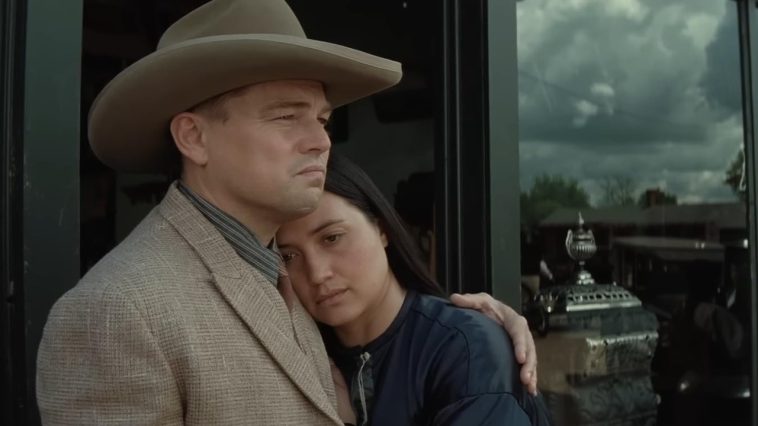Leonardo DiCaprio recently expressed his deep gratitude for the opportunity he was given to star in the film ‘Killers of the Flower Moon’.
The movie is an adaptation of a widely popular book by David Grann, which narrates the true story of multiple mysterious deaths that plagued the wealthy Osage Nation in the 1920s. These heinous crimes, famously known as the Osage Reign of Terror, are at the core of Martin Scorsese’s gripping film, which was released on October 20th.
When the film was initially in its promotional phase, the cast including DiCaprio remained silent due to the ongoing SAG-AFTRA strike. However, with the dispute eventually resolved, the cast was free to publicly discuss the movie.
In a virtual press conference that lasted just beyond half an hour, DiCaprio took the stage along with co-stars Lily Gladstone, Robert De Niro, Jesse Plemons, and director Martin Scorsese to answer various questions from the media.
DiCaprio was quizzed about his experience portraying the deeply conflicted character, Ernest Burkhart. His character is depicted as a man torn by loyalties, manipulated and influenced by his authoritative uncle William Hale, played by Robert De Niro. In the narrative of the film, Burkhart betrays his Osage wife, Mollie, portrayed brilliantly by Lily Gladstone.
The actor, while addressing the media, segued into discussing the lasting impacts of the Osage Reign of Terror visible today in Oklahoman communities. He commented, ‘The repercussions of these devastating events passed down through generations are evident even now, a hundred years later in Oklahoma. These injustices have not been erased and can certainly be seen in today’s society.’
For DiCaprio, his time spent bringing Ernest to life was primarily about channeling the deeply personal narratives of the communities involved: ‘When portraying Ernest, my sole intention was to manifest the authenticity of those accounts and depict the relationship between Mollie and him in the most genuine light possible.’
In his reflections, DiCaprio highlighted the unique manner in which ‘Killers of the Flower Moon’ unravels – where regions with immense natural resources often become landscapes marred by violence.
‘This pattern is not exclusive to America – it is a global phenomenon,’ DiCaprio remarked. ‘This narrative serves as a smaller representation of a broader issue surrounding Indigenous communities and their homelands – an issue that continues to persist to this very day.’
The actor was struck by the grim revelations that came with understanding the crux of the story. ‘The realization that this narrative has current-day relevance and is not confined to the past was deeply unsettling,’ DiCaprio confessed.
The initial script of the film didn’t extensively explore the relationship between Ernest and Mollie, focusing primarily on the whodunnit aspect of the murders. DiCaprio acknowledged how Scorsese’s distinctive creative style switched the narrative focus to emphasize the human emotions and individual characters. ‘Working with Marty, what becomes clear is that the plot takes a backseat to his exploration of the human psyche,’ DiCaprio shared.
In an interesting twist, the storyline shifted during production to center more around the turbulent relationship between Ernest and Mollie. Initially slated to play the role of Tom White, the FBI agent assigned to investigate the murders, DiCaprio switched characters to play Ernest, passing the baton of law enforcement to Jesse Plemons.
Plemons, while discussing his character Tom White, acknowledged the vast amount of preparatory work conducted before his arrival. ‘By my arrival, the amount of groundwork already laid was truly commendable. I was gifted a research packet, stuffed with comprehensive information about Tom White, in addition to David Grann’s book,’ said Plemons.
Tension arose surrounding the question of how vital it was for the ‘Killers of the Flower Moon’ team to work cohesively with the Osage Nation. Additionally, questions were fielded to DiCaprio and De Niro about their recurring partnerships with Scorsese, and to DiCaprio and Gladstone about molding the complex dynamics of Mollie and Ernest’s relationship.
To gain a deeper, more authentic understanding of their characters, DiCaprio and Gladstone met with descendants of the real-life Ernest and Mollie. ‘While their story might seem unbelievable to those who watch the movie and are taken aback by Ernest’s heinous actions and Mollie’s awareness, the narrative is grounded in indisputable facts,’ DioCaprio underlined.
DiCaprio further emphasized that the story has been deeply internalized by the Osage community, even though it might not have been openly discussed. ‘Reliving these haunting specters and tales from the past a hundred years later felt surreal for all of us,’ he said.
Finally, DiCaprio emphasized how honored he felt to be a part of a film that sheds light on a tragically overlooked part of history. ‘To be involved in unveiling a century-old narrative of a community that hasn’t been widely discussed was an absolute privilege,’ DiCaprio concluded.
In this retelling of a horrifying chapter from the 1920s, ‘Killers of The Flower Moon’ brings to the forefront the stories of the Osage Nation that have remained in the shadows for too long. With a cast of celebrated actors and under the direction of the acclaimed Martin Scorsese, the film promises to be a significant contribution to historical narratives through the medium of cinema.


